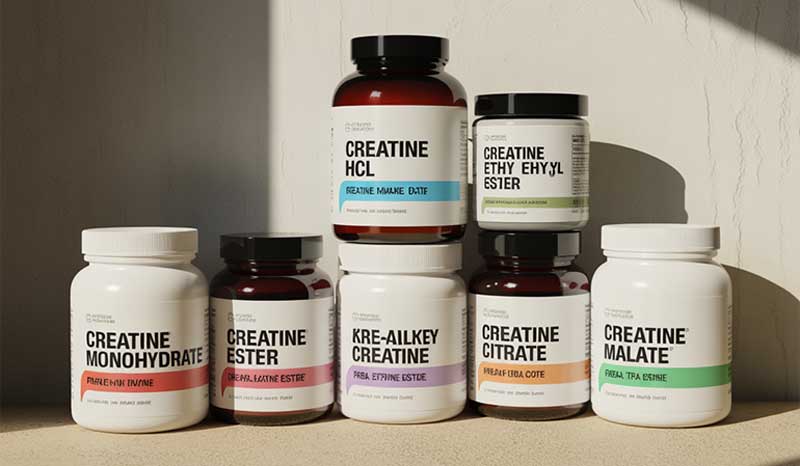Which Type of Creatine Is Best? Full Comparison Guide
Creatine is one of the most researched and widely used supplements in the fitness world.
It's renowned for enhancing strength, power, and muscle mass during high-intensity workouts.
However, with various forms of creatine available in the market, it can be challenging to determine which type is best suited for your fitness goals.
This guide aims to provide clarity on the different types of creatine, their benefits, and how to choose the right one for your needs.
Creatine: What Is It?
Creatine is a naturally occurring compound found in small amounts in certain foods and synthesized by the body from amino acids.
It plays a crucial role in energy production during high-intensity, short-duration activities like sprinting, weightlifting, and explosive movements.
By supplementing with creatine, individuals can increase their muscle stores of phosphocreatine, leading to improved performance and muscle growth.
Choosing the Right Creatine: A Complete Guide
Creatine monohydrate is the best choice, proven, effective, affordable, and backed by extensive research for strength and muscle gains.
- Choosing the right creatine depends on your fitness goals and how your body responds. Focus on effectiveness, absorption, and tolerance.
- Some forms are highly soluble, reducing digestive discomfort, while others are designed for maximum stability and long-term use.
- Consider your workout type: strength, power, or endurance, to select a form that supports energy production and muscle recovery.
Consistent use, proper dosing, and a balanced diet are key to seeing optimal results.
The Gold Standard: Creatine Monohydrate
Creatine monohydrate is the most studied and widely used form of creatine.
It consists of a creatine molecule bound with a water molecule, making it highly effective and affordable.
✅ Benefits:
-
Proven Effectiveness: Numerous studies have demonstrated its ability to enhance strength, power, and muscle mass.
-
Safety: Creatine monohydrate has a well-established safety profile when used correctly.
-
Cost-Effective: It offers a high-quality supplement at an affordable price point.
Considerations:
-
Water Retention: Some users may experience water retention, leading to temporary weight gain.
-
Digestive Issues: A small percentage of individuals might experience stomach discomfort or bloating.
Despite these minor drawbacks, creatine monohydrate remains the gold standard due to its extensive research backing and proven benefits.
Creatine Hydrochloride (HCl): The Solubility Advantage
Creatine HCl is a newer form of creatine that has gained popularity due to its enhanced solubility in water.
This increased solubility may reduce the likelihood of digestive discomfort.
✅ Benefits:
-
Better Solubility: Easier to mix and potentially gentler on the stomach.
-
Lower Dosage: Some manufacturers claim that a smaller dose is needed for effectiveness.
Considerations:
-
Limited Research: While promising, there is limited research comparing creatine HCl to creatine monohydrate in terms of performance benefits.
-
Higher Cost: Creatine HCl is often more expensive than creatine monohydrate without conclusive evidence of superior benefits.
Creatine Ethyl Ester: The Absorption Claim
Creatine ethyl ester is a form of creatine that has been esterified to improve its absorption rate.
Some proponents claim it requires a smaller dose and is better absorbed by the body.
✅ Benefits:
-
Potential for Better Absorption: The esterification process may enhance creatine uptake into muscles.
Considerations:
-
Mixed Research Results: Studies have shown mixed results regarding its effectiveness compared to creatine monohydrate.
-
Taste and Stability Issues: Creatine ethyl ester may have a bitter taste and lower stability, potentially affecting its shelf life.
Buffered Creatine: pH-Corrected for Stability
Buffered creatine, often marketed as Kre-Alkalyn, is creatine monohydrate that has been processed to have a higher pH level.
The theory is that this buffering process prevents the breakdown of creatine into creatinine, a waste product, before it reaches the muscles.
✅ Benefits:
-
Stability: Higher pH may reduce the conversion of creatine to creatinine.
-
Reduced Side Effects: Some users report fewer digestive issues.
Considerations:
-
Lack of Strong Evidence: Research comparing buffered creatine to standard creatine monohydrate is limited.
-
Increased Cost: Buffered creatine is typically more expensive without substantial evidence of superior benefits.
Creatine Citrate and Creatine Malate: Specialized Forms
Creatine citrate and creatine malate are forms of creatine bound with citric acid and malic acid, respectively.
These forms are often marketed for their improved solubility and potential benefits for endurance athletes.
✅ Benefits:
-
Enhanced Solubility: Better mixing in water, potentially reducing stomach discomfort.
-
Additional Benefits: The acids may provide additional energy production benefits.
Considerations:
-
Lower Creatine Content: These forms contain less creatine per dose compared to monohydrate.
-
Higher Cost: Due to additional processing, they are often more expensive.
Choosing the Right Creatine for Your Goals
When selecting a creatine supplement, consider your specific fitness goals, budget, and any potential sensitivities.
-
For General Strength and Muscle Growth: Creatine monohydrate is the most effective and cost-efficient choice.
-
For Those with Digestive Sensitivities: Creatine HCl may be a gentler option.
-
For Endurance Athletes: Creatine citrate or malate might offer additional benefits due to their solubility and energy production properties.
Always consult with a healthcare professional before starting any new supplement regimen, especially if you have underlying health conditions or are taking medications.
Conclusion
Creatine is a powerful supplement that can enhance performance, strength, and muscle growth.
While various forms are available, creatine monohydrate remains the most researched and effective option for most individuals.
By understanding the different types of creatine and aligning them with your fitness goals, you can make an informed decision that supports your health and performance objectives.


